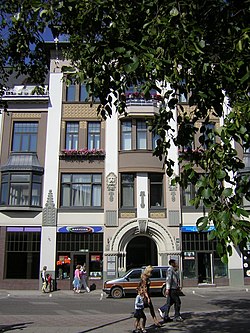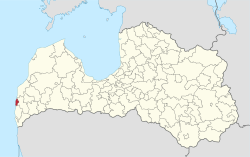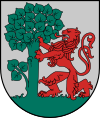Libau, Courland
| Liepāja | |||
|---|---|---|---|
| City | |||

Art Nouveau architecture in Liepāja.
|
|||
|
|||
 Location of Liepāja within Latvia |
|||
| Coordinates: 56°30′42″N 21°00′50″E / 56.51167°N 21.01389°ECoordinates: 56°30′42″N 21°00′50″E / 56.51167°N 21.01389°E | |||
| Country |
|
||
| Town rights | 1625 | ||
| Government | |||
| • Mayor | Uldis Sesks | ||
| Area | |||
| • Total | 60.4 km2 (23.3 sq mi) | ||
| • Water | 10.87 km2 (4.20 sq mi) | ||
| Population | |||
| • Total | 82,386 | ||
| • Density | 1,398/km2 (3,620/sq mi) | ||
| Time zone | EET (UTC+2) | ||
| • Summer (DST) | EEST (UTC+3) | ||
| Postal code | LV-34(01-13); LV-3414; LV-34(16–17) | ||
| Calling code | +371 634 | ||
| Number of city council members | 15 | ||
Liepāja (pronounced [liepaːja]), (German: Libau; see other names) is a city in western Latvia, located on the Baltic Sea directly at 21°E. It is the largest city in the Kurzeme Region and the third largest city in the country after Riga and Daugavpils. It is an important ice-free port, although its harbour is not deep. In 1875 its population was 10,000 As of 1 July 2011, Liepāja had a population of 83,500.
In the 19th and early 20th century it was a favourite place for sea-bathers with the town boasting a fine park and many pretty gardens, and a theatre. Liepāja is however known throughout Latvia as "City where the wind is born", likely because of the constant sea breeze. A song of the same name (Latvian: "Pilsētā, kurā piedzimst vējš") was composed by Imants Kalniņš and has become the anthem of the city. Its reputation as the windiest city in Latvia was strengthened with the construction of the largest wind farm in the nation (33 Enercon wind turbines) nearby.
The Coat of Arms of Liepāja was adopted four days after the jurisdiction gained city rights on 18 March 1625. These are described as: "on a silver background, the lion of Courland with a divided tail, who leans upon a linden (Latvian: Liepa) tree with its forelegs." The flag of Liepāja has the coat of arms in the center, with red in the top half and green in the bottom.
It is said that the first settlement at the location of modern Liepāja was known by the name Līva from the name of the river Līva on which Liepāja was located. The name was derived from the Livonian word Liiv meaning "sand". The oldest written text mentioning the Latvian name is said to be dated 4 April 1253. In 1263, the Teutonic Order established a town which they called Libau in German. The Latvian name Liepāja was mentioned for the first time in 1649 by Paul Einhorn in his work Historia Lettica. A Russian name from the time of the Russian Empire was Либава or Либау, although Лиепая, a transliteration of Liepāja has been used since World War II.
...
Wikipedia


